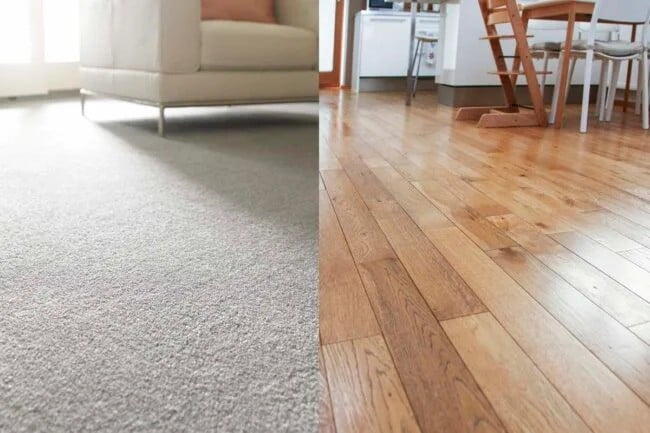Choosing the right flooring for your home goes beyond aesthetics, influencing daily comfort, maintenance, and property value. This guide focuses on carpet and laminate flooring, two popular choices with distinct benefits and drawbacks.
By comparing their costs, advantages, and important considerations, we aim to provide the insights needed to select a flooring option that best fits your lifestyle, budget, and design preferences.
Understanding Carpet Flooring

Description and Common Types
Carpet flooring, known for its warmth and comfort, has been a home staple for decades. It’s made from woven fibres and comes in various types, including nylon, polyester, wool, and olefin. Each material offers different textures, durability, and price points, catering to multiple tastes and needs. The common types of carpet include plush, Berber, frieze, and textured, each providing a unique feel and appearance to a room.
Pros of Carpet Flooring
- Comfort and Warmth: The carpet is unparalleled in adding a cosy and warm atmosphere to any space, making it ideal for bedrooms and living areas.
- Sound Insulation: Thanks to its dense fibres, carpet flooring absorbs sound, creating a quieter and more serene home environment.
- Variety in Textures and Colors: With an extensive range of styles, patterns, and hues, carpet flooring offers limitless possibilities to match any room’s decor and homeowner’s taste.
Cons of Carpet Flooring
- Maintenance Challenges: The carpet requires regular vacuuming and occasional deep cleaning to maintain its appearance and hygiene, posing a challenge for those with busy lifestyles.
- Allergen Retention: Carpets can trap dust, pet dander, and other allergens, which might concern individuals with allergies or respiratory issues.
Average Cost Range
The cost of carpet flooring can vary widely based on the installation’s material, quality, and complexity. On average, homeowners can expect to spend between $3 to $7 per square foot for materials and installation. High-end carpets, such as plush wool, can exceed these averages, while more budget-friendly options like olefin or polyester may fall on the lower end of the spectrum.
Understanding Laminate Flooring

Description and Common Types
Laminate flooring, a versatile and durable option, mimics the appearance of hardwood floors at a significantly lower cost. It comprises a composite material with a photographic applique layer under a transparent protective coating replicating various wood grains and finishes. The common types of laminate flooring include textured, smooth, distressed, and embossed in register, each offering a different aesthetic appeal and feel underfoot.
Pros of Laminate Flooring
- Durability and Resistance to Scratches: Laminate floors are known for their hard surface that withstands dents, scratches, and daily wear and tear, making them ideal for high-traffic areas.
- Ease of Maintenance: Laminate flooring does not require special cleaners or treatments, unlike hardwood floors. Regular sweeping and occasional damp mopping keep these floors looking new.
- Appearance of Hardwood at a Lower Cost: Laminate offers the beauty of hardwood floors without the high price tag, allowing homeowners to achieve a luxurious look on a budget.
Cons of Laminate Flooring
- Not as Warm or Soft Underfoot: Laminate, a more rigid material, provides a different level of comfort and warmth than carpet flooring.
- Can Be Slippery: The smooth surface of laminate flooring can be slippery, especially when wet, posing a risk of falls.
- Susceptible to Moisture Damage: Although laminate floors are somewhat resistant to spills, standing water can seep into the seams and cause warping or bubbling.
Average Cost Range
Laminate flooring costs typically range from $2 to $5 per square foot, including materials and installation. The price can vary based on the quality of the laminate, the complexity of the installation process, and the underlayment used. Higher-end laminate floors that closely mimic the look of natural wood can be more expensive but still offer a cost-effective alternative to hardwood.
Cost Comparison

Direct Cost Comparison
When comparing the initial installation costs of carpet and laminate flooring, carpet often comes out as the more budget-friendly option, with average prices ranging from $3 to $7 per square foot. In contrast, laminate flooring costs between $2 to $5 per square foot. However, the long-term maintenance costs for laminate tend to be lower than carpet, as laminate requires less intensive care and is more durable against wear and tear.
Long-Term Maintenance Costs
Carpet flooring necessitates regular vacuuming and professional cleaning to maintain its appearance and hygiene, which can add to the overall cost over time. Laminate flooring, with its ease of maintenance, requires less frequent and less costly care, potentially leading to savings in the long run.
Factors Influencing Cost

- Quality of Materials: The quality and type of material chosen for either flooring option significantly affect the price. High-quality carpets and high-end laminate floors will be more expensive, durable, and aesthetically pleasing.
- Complexity of Installation: The cost can also vary based on the complexity of the installation. Rooms with unusual shapes or a need for extensive subfloor preparation can increase the overall cost for both types of flooring.
Understanding these cost dynamics is crucial for homeowners to make informed decisions based on initial investment and long-term value. While laminate flooring may offer a more durable and low-maintenance solution, the comfort and warmth of carpet might be preferable for specific living spaces, making it essential to weigh these factors against personal preferences and lifestyle needs.
The Bottom Line
Choosing between carpet and laminate flooring is a multifaceted decision that extends beyond cost to include lifestyle compatibility, aesthetic preference, and long-term practicality. By weighing these factors carefully and consulting with professionals, you can select a flooring option that suits your budget, complements your home, and enhances your living environment. Ultimately, the right choice aligns with your needs and ensures your satisfaction for years.

